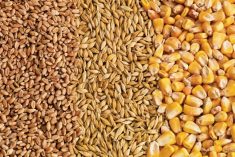Glacier Farm Media | MarketsFarm – As winter conditions descended on Alberta, prices for feed grains bumped up a little, but were otherwise “percolating sideways,” stated Jim Beusekom of Market Place Commodities in Lethbridge.
“Barley prices are slowly moving higher. It’s a little bit of a logistics play. We finally have some winter, with snow, slippery roads, and some slowdown of truck traffic as everybody resets themselves on how to move product in winter,” he explained.
Pressure on feed prices was coming from the futures markets as grains and oilseeds were either dropping back or drifting sideways, Beusekom said.
Read Also

U.S. grains: Soybeans rise on China demand hopes; corn and wheat rebound
Chicago Board of Trade soybean, corn and wheat futures rose on Monday on signs of progress towards the end of a record-long U.S. government shutdown, along with expectations of a revival of U.S. soybean exports to China, analysts said.
He said feed barley prices in Alberta rose C$2 to C$3 per tonne over the last week, reaching C$285 to C$290/tonne delivered into Lethbridge. Meanwhile, feed wheat was a little more expensive as it fetched around C$300/tonne.
“We’re in a year where there’s really not that much wheat that’s been downgraded to feed,” Beusekom said. “They’re paying the same for what the elevators pay for winter wheat or the lowest grade hard red spring wheat.”
He said those feed wheat prices have shifted away from following values for barley and corn, to being in concert with export prices.
As for corn imports from the United States, Beusekom said those are starting to pick up as the harvest had wrapped up.
“There’s as much available as (the Prairie feed market) wants,” he stated.
















